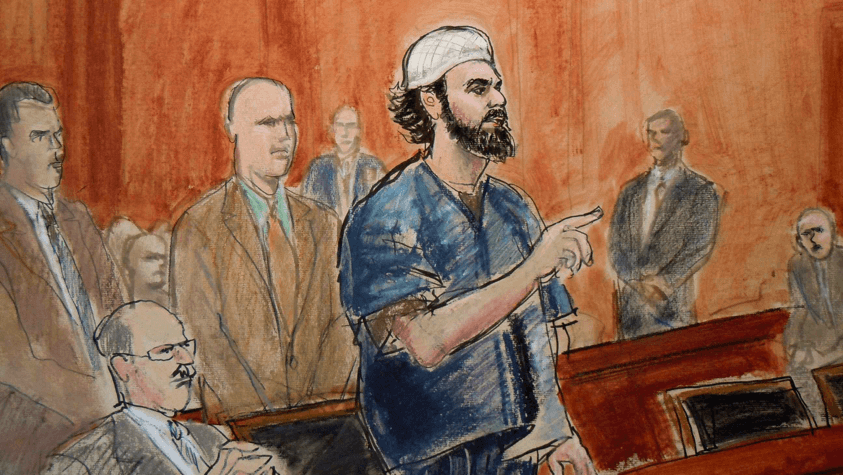By TACP Staff on July 08, 2021

Courtroom sketch artists are individuals who record and report trials using visual art creations. While many trials allow cameras to be present in the courtroom, judges can ban their use in trials that require discretion. The depictions of courtroom events and emotions are utilized by the media to inform the public in areas such as; the nature and tenor of testimony, emotional climate and the specifics of evidence presentation.
Courtroom sketch art is an artistic representation of courtroom environments and trial proceedings.
Centuries ago, when cameras weren’t invented – or at least as common as they are now – courtroom sketches were the only way that many people could get a glimpse of what happened during a court trial. These types of sketches were used during the infamous Salem Witch Trials of the 17th century, for instance.
After cameras became more commonplace, sketches were still used to depict the goings-on of most courtroom trials. This is mostly due to the fact that early cameras were ultimately ineffective at capturing movement. They were also large obtrusive contraptions that many key courtroom players – such as jury members and witnesses – found very distracting.
It wasn’t until the late 20th century that many jurisdictions began allowing photographers into their courtrooms. By this time, cameras were much smaller and less distracting than previous models. Even with the advancements of modern photography, there is still a need for courtroom sketch artists.
Some jurisdictions, for example, still do not allow cameras of any kind in their courtrooms. In many jurisdictions, judges may decide to put a ban on cameras in the courtroom for nearly any reason. Cameras are sometimes banned from court trials of a particular nature, for instance, such as high profile cases or cases involving minors.
Simply put, a courtroom sketch artist draws courtrooms scenes during trials. In some cases, depending on the rules and regulations of a courtroom or jurisdiction, a courtroom sketch artist may need to get prior permission to do this type of work.
A courtroom sketch artist will usually arrive several minutes before the start of a trial. Thinking ahead like this can allow the artist to get the best seat possible, with a clear view of all the action. In fact, some courtrooms even have designated seats for courtroom sketch artists.
Some trials may last a few days or less, while others may last as long as several months. In general, most courtroom artists should be prepared to attend every part of the trial in order to record as much of it as possible.
Some jurisdictions allow courtroom sketch artists to sketch while the trial is taking place. These artists must be able to draw very quickly and be able to decide which scenes are worth sketching and which scenes aren’t. For instance, a courtroom artist won’t usually sketch a moment when there is a lull in courtroom activity. Instead, he will usually sketch more memorable scenes, such as particularly emotional witnesses or the jury foreman reading the verdict.
In some jurisdictions, such as the UK, a courtroom artist is not allowed to sketch during the trial itself. Instead, he must wait until court is recessed or adjourned and create his sketches from memory. Obviously, a courtroom sketch artist in this situation must have an excellent memory as well as speed.
The tools that a sketch artist uses are generally quite simply; usually, all that is necessary is a sketch pad and drawing implements of some kind. Depending on an artist’s preference, these can include graphite pencils, colored pencils, pastels, and chalk.
A formal education is not always necessary for a successful courtroom sketch art career, but it can be very helpful. Most individuals pursuing a courtroom sketch art career will often find that a degree from an accredited art school can help them hone their skills and gain experience.
When pursuing an education for a courtroom sketch art career, students should earn drawing degrees. Some courses that may come in useful for this type of career may include portrait drawing, caricature drawing, and life drawing. All of these types of drawing help artists capture the human form.
According to the Bureau of Labor Statistics, courtroom sketch artists fall under the category of fine artists. These art professionals made an average annual salary of $48,960 in 2018.
Predicting the salary of a courtroom sketch artist, however, can be somewhat difficult. In general, though, these types of artists are usually paid per piece of art they create. Obviously, faster and more talented artists will be able to command a higher wage in this industry. Also, artists that list in larger jurisdictions that frequently do not allow cameras in their courtrooms will also be able to make more money as well.
The majority of courtroom sketches are typically printed in periodicals featuring coverage of the trials. Websites, and online magazines and news venues, might also feature courtroom sketch art. In the case of high profile cases, courtroom sketches might also be used as illustrations in books about the crimes or trials.
In a few cases, a courtroom sketch artist might also be able to sell their sketches to private buyers as well. Key players in the trial – including lawyers, judges, and jury members – may wish to purchase a piece of original art as a memento of a particularly memorable trial. Selling courtroom sketches of high profile trials can also be quite lucrative as well.
Consider these related careers in Craft and Fine Art.

The Art Career Project is a trusted resource for emerging and professional artists.